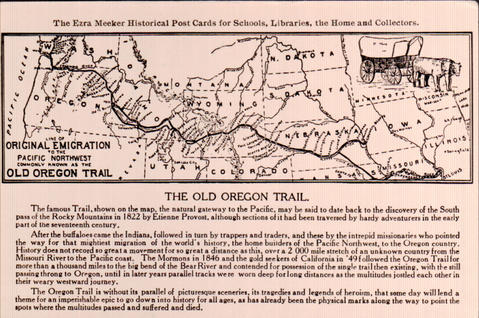Identity elements
Reference code
Name and location of repository
Level of description
Part
Title
SUSAN-002 Front
Date(s)
- c. 1910 (Creation)
Extent
Content and structure elements
Scope and content
- A map showing the "Line of Original Emigration to the Pacific Northwest commonly known as the Old Oregon Trail." This card was part of a series sold by Washington State pioneer Ezra Meeker between 1906-1912. During this period, Meeker, one of the first emigrants to cross the trail in 1852, re-crossed it again twice by ox team and wagon, raising monuments along the way to commemorate the Trail's original pioneers.
- Printed on front: The Old Oregon Trail. The famous Trail, shown on the map, the natural gateway to the Pacific, may be said to date back to the discovery of the South pass of the Rocky Mountains in 1822 by Etienne Provost, although sections of it had been traversed by hardy adventurers in the early part of the seventeenth century. After the buffaloes came the Indians, followed in turn by trappers and traders, and these by the the intrepid missionariies who pointed the way for that mightiest migration of the world's history, the home builders of the Pacific Northwest, to the Oregon country. History does not record so great a movement for so great a distance as this, over a 2,000 mile stretch of an unknown country from the Missouri River to the Pacific coast. The Mormons in 1846 and the gold seekers of Californina in '49 followed the Oregon Trail for more than a thousand miles to the big bend of the Bear River and contended for possession of the single trail then existing, with the still passing throng to Oregon, until in later years parallel tracks were worn deep for long distances as the multitudes jostled each other in their weary westward journey. The Oregon Trail is without its parallel of picturesque sceneries, its tragedies and legends of heroism, that some day will lend a theme for an imperishable epic to go down into history for all ages, as has already been the physical marks along the way to point the spots where the multitudes passed and suffered and died.

